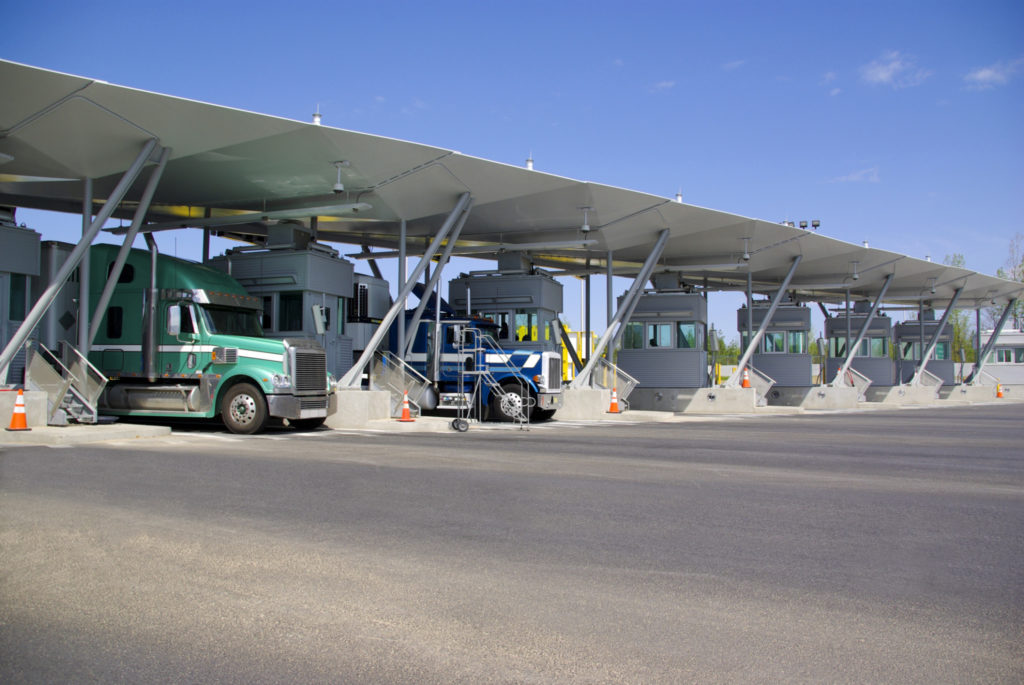Telematics shows Covid-19 having mild to moderate impact on trucking activity
Heavy-duty trucking has continued to drive forward during the Covid-19 crisis, operating at around 89% of its normal rate of activity, according to telematics data from Geotab, compared to 69% for passenger vehicles.
Considering the overall impact of Covid-19 on businesses and consumers across North America, the fact that trucking – considered to be an essential service – has only seen moderate declines, is somewhat of a surprise. Particularly when it comes to cross-border activity, which was closed down to all non-essential traffic March 21.
“With the shutdown of many non-essential businesses across North America and the unprecedented impact on the economy, we expected a stronger decline in cross-border traffic,” said Daniel J. Lewis, senior data scientist and research and development specialist for Geotab. “However, with the increase of demand for essential goods, such as toiletries and groceries, as well as the continued operation of home delivery services, there remains a strong demand for continued operation of the trucking supply chain.”
Geotab’a data shows that on average, the Canadian commercial transportation industry is operating at 79% of normal activity across all vehicle types since March 15. Similar to that of the U.S., which is at 82%.
“While many communities across North America and the world are declaring a state of emergency and are mandating the closure of non-essential businesses, trucking and logistics companies are continuing to deliver the goods that we rely on every single day,” said Neil Cawse, CEO of Geotab. “We at Geotab send our sincere gratitude to all truck drivers, along with health care workers, grocery store employees and many more who are continuing to provide the services and goods that we need.”
Canada’s Maritime provinces has seen the steepest decline in truck activity, operating at 69% of its normal commercial transportation levels. In the U.S., the states of New York and New Jersey, considered the North American epicenter of the coronavirus, is down to 63% compared to its normal activity.
It should come as no surprise that grocery store demand is the reason behind much of the continued need for trucking, accounting for 90% of the flow of commercial transportation activity according to data collected March 27.
By comparison, the movement of goods to most retail stores has declined anywhere from 20%-30%. Warehouse activity is holding steady at 82% of its normal rate, while industrial has seen a decline of 25%.
Lytx has also looked at its telematics data to determine the impact the Covid-19 response has had on trucking, and found the industry has seen an overall reduction in mileage and the number of trips.
Between March 1-22, mileage racked up by truck traffic was down 6%, and the number of trips fell by 1%.
General freight saw a 5% decline in mileage and 1% drop in the number of trips, while specialized freight was down 3% for the number of trips and 2% for miles traveled.
With passenger vehicle travel down due to stay-at-home requests from various provinces and states, trucking has also seen a reduction in interactions with other drivers on the road.
Lytx data reveals that collisions are down 28%, and near collisions, both avoidable and unavoidable, are down 25% and 23% respectively.
“These numbers are consistent with our expectations, both in terms of mileage, risk, and collisions, given the shutdown of non-essential businesses across the country,” said Kyle Warlick, client intelligence analyst for Lytx. “We know from both academic research, our own analyses of over the past several decades, and anecdotally from Lytx customers that driving risk is significantly heightened by the presence of other vehicles on the road, especially lower-volume or passenger vehicles.”
Warlick added that when it comes to the amount of mileage being driving by commercial trucks, the moderate drop shows how essential the industry is, even during a pandemic.
“More than anything,” he said, “we are grateful to these drivers for the hard work they are doing and excited to see so many other people realizing the importance of this industry and going out of their way to thank drivers for continuing to show up in this troubling time.”
Despite what have been mild to moderate declines in trucking activity, depending on the type of business being serviced, fuel purchases remain similar to post-Covid-19 totals.
Geotab data shows steep declines in fuel purchases for passenger vehicles, buses, and multipurpose vehicles, like vans, but holding steady for light-, medium-, and heavy-duty trucks.
At the Canada-U.S. border, truck volumes have dropped since early March, as have wait times.

Data collected at the Detroit-Windsor, Fort Erie, Queenston, and Sarnia ports of entry show a truck traffic decline of 30% between Feb. 1 and March 15.
“The volume reduction in cross-border truck movement is possibly due to the reduction of demand for non-essential goods,” said Lewis. “We are noticing what we think is a corresponding decrease in cross-border movement – which has been stabilizing over the past several days – and will continue to monitor this.
“We are grateful to these drivers for the hard work they are doing and excited to see so many other people realizing the importance of this industry.”
Kyle Warlick, Lytx
“Aside from national holidays such as Christmas, where we always see a reduction in cross-border travel, we have not seen a similar impact from any other events. The impact from holidays is only transient and we haven’t seen a sustained decrease like we see now.”
Omnitracs also recognizes the impact Covid-19 is having on truck drivers, with CEO Ray Greer saying though the supply chain has never been more vital, disruption is inevitable.
“Delivery delays, larger workloads, longer wait times, and lack of open rest areas for truckers are just a few challenges fleets are facing right now,” said Greer. “Yet, it is absolutely critical that supply chain and logistics continues operating as seamlessly as possible for daily life to continue.”
Greer said real-time data for routing and rerouting is critical during the relief effort, both to ensure timely deliveries and keep drivers safe.
“The supply chain must be nimble, and that requires streamlining data access and mobilizing it to all employees, including drivers, so they can avoid long wait times at loading docks or unsafe parking areas, and get their jobs done more efficiently and safely,” he said. “Data should also be used to monitor vehicles to avoid system failures, to safeguard delivery of essential items for food or relief.”

Dan Khasis is a logistics technology expert and founder of Route4Me (R4M), a route optimization network that is making its software available in all countries as an unlimited free trial to federal, state, and municipal government agencies, as well as foodbanks. The free trial will be available until the peak of the Covid-19 outbreak passes.
Through its software, R4M is seeing delivery times drop due to a reduction of traffic in cities across the U.S.
Driving speed for deliveries in Seattle, for example, have increased from 37 mph to 42 mph, as more customers relied on e-commerce to avoid leaving their homes.
“Traffic related delays and expenses, which previously could have increased costs by two times, are no longer much of an issue,” said Khasis. “Most people are home all day, so delivery windows are wide open, and being early or late is probably no longer relevant, since people have few places to legally go.”
Other factors Khasis sees contributing to speedier delivery times include increased parking availability and the ability to complete additional deliveries because of less holdups on the road.
Greer added that despite the need for continued deliveries during the pandemic, driver health and safety should be paramount.
“A healthy truck driver could mean the difference between a hospital receiving necessary gear to treat patients,” he said, “or a family being able to purchase food.”
Have your say
This is a moderated forum. Comments will no longer be published unless they are accompanied by a first and last name and a verifiable email address. (Today's Trucking will not publish or share the email address.) Profane language and content deemed to be libelous, racist, or threatening in nature will not be published under any circumstances.
I run long haul out of Calgary, AB. I run to all parts of Canada and the USA, typically away from home for 18-24 days at a time. I feel that when a driver like myself is ready to return home for a few days off with his partner/family, he becomes a member of the community once more and his status as a trucker, exempt from the 14-day self isolation requirement becomes irrelevant. In other words, it would be irresponsible to re enter the community, and especially one’s own home without first completing 14 days isolated and alone. The impracticality of finding, paying for, moving into and supplying alternative accommodations for 14 days every time I return from a tour is crazy, yet it is non-negotiable — it must be done to protect family and community from Coronavirus that I may have contracted on the road, precautions and due care having been taken, but notwithstanding. For these reasons, I have decided to suspend my trucking career until Covid-19 is substantially under control and these measures are no longer necessary. It is unfortunate because business at my carrier is booming at the moment, not to mention that I truly love my trucking life and thrive on the road. I just feel that at present, avoiding the virus is the overwhelming priority. I’m reasonably healthy, but not perfectly healthy. I’m in my late 50s and the prospect of getting critically ill far from home without contact of my loved ones is simply too great a risk to take. Truck stops and supermarkets are not safe places, and with every visit to the Flying J or the Walmart, you become filled with anxiety that does not disappear when you return to the safety of your truck. I’m staying home for a while. I want to live to fight another day.
We put be looking at putting truck drivers up in a hotel after coming back from making deliveries in New York City as a real risk of them getting C 19 and spreading it . We have do a better job of protecting our truck drivers . We need to have more places to wash up and do laundry.